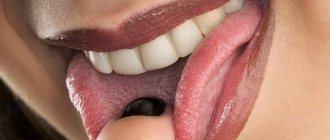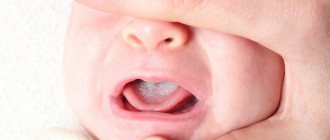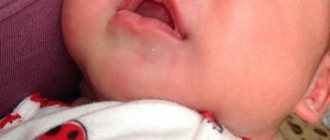What is thrush
Thrush (or candidiasis) is a type of stomatitis (inflammation of the mucous membrane in the mouth) caused by a yeast-like fungus of the genus Candida. It is this fungus that causes the disease, usually transmitted through contact with an infected person.
The fungus is not a “guest” in the body: like other microorganisms, it always lives on the mucous membranes of the intestines, genitals, and mouth, but in small quantities. However, such a normal state is possible only with a “friendly” balance of “good” and “harmful” bacteria representing the microflora of the human body. This balance of equilibrium can be disrupted upon contact with a patient with thrush: in this case, a fungal infection from the outside enters the body of a healthy person and begins to multiply quickly there, disrupting the natural microflora.
This is possible when the immune system is weakened, when the number of “good” bacteria sharply decreases, and they are unable to fight the growing number of “harmful aliens.”
The occurrence of thrush in the mouth in children over the age of one year is explained by the fact that when they come into contact with each other, they pass toys and objects that they take in turn in their mouths, and among them there is often at least one child infected with candidiasis. And since the child’s immunity is still in the development stage, its internal protection is weakened, so infection occurs very quickly.
Pathogen dossier
What are the causative agents of the disease? Candida fungi are present almost everywhere: in the air, on the surface of any objects, including food, which means they can be transmitted by air, through food, or by contact. They are also present in limited quantities in the human body. With a decrease in immunity, hormonal changes, long-term use of antibiotics or dysbacteriosis, our body ceases to restrain their reproduction, which causes inflammatory processes on the skin and mucous membranes. Candida feed on sugar, releasing toxins that help reduce the body's immune properties. The main cause of thrush in children is the Candida albicans (white) strain. Of the variety of known varieties of fungi of this genus, the most dangerous strains are Candida lusitanlae, Candida glabrata and Candida krusei, which are resistant to some antifungal drugs.
Symptoms of thrush in the mouth of a baby
What does thrush look like in a baby? When a fungal infection enters the child’s oral mucosa, its proliferation leads to inflammation in the mouth area. Therefore, quite quickly you will be able to notice small crumbs of white “cereal”, reminiscent of cottage cheese, on the child’s cheeks, palate, gums and tongue. An inexperienced mother may well assume that this is the remains of milk or formula after regurgitation. But checking whether this is so is quite simple: take dry sterile gauze or a bandage and very carefully try to remove the white coating. If these are really leftover food, they will be easily removed; if it is thrush, it will be more difficult to erase the curdled coating. And after removing it, you will notice inflamed redness in the oral cavity. If your baby has thrush, his appetite and sleep will most likely worsen, and he will become restless and moody.
When there is no reason to worry
White lips in a baby may be normal. After breastfeeding, a milky streak remains on the baby's lips, which disappears within a few minutes. The same phenomenon is observed in children fed formula. On the tongue, the inside of the cheeks and the palate, curdled lumps may remain when regurgitated. You can remove them yourself using sterile gloves or a bandage.
If after cleaning the plaque forms again, this is a reason to consult a pediatrician. It is necessary to monitor the manifestation of accompanying symptoms: refusal to eat, frequent severe crying, and fever.
Causes of oral thrush in newborns
How can Candida fungi get into a baby’s body?
- infection can occur during the mother’s pregnancy if she suffers from genital candidiasis on the eve of childbirth: during the birth process, a fungal infection enters the placenta and amniotic fluid, and then into the newborn’s body;
- a baby can also become infected from a nursing mother if her nipples are affected by a fungal infection;
- when a child is bottle-fed or sucks on a pacifier, it, as well as bottles and nipples, must be treated in a sterilizer or boiled water before giving it to the newborn; unsterile nipples can cause bacteria to enter the oral cavity;
- the fungus can live not only on the mucous membrane, but also on the skin of the hands, from where it can easily migrate to the skin of the child if he is cared for by a person affected by thrush;
- The fungus can also be found in pet hair, dust, raw vegetables, meat or milk, so after contact with all these “transmitters” of bacteria, you must wash your hands thoroughly before touching the newborn;
- treatment with antibiotics can also disrupt the natural balance of the body's microflora; as a result of antibiotic therapy, candidiasis occurs in mother and baby who did not take medications containing “beneficial” bacteria along with antibiotics;
- candidiasis can occur if the mother has not learned how to properly attach the baby to the breast during feeding; the child may swallow too much air when sucking and, as a result, often burp; under such circumstances, most of the dairy food can remain in the child’s mouth, giving rise to fermentation processes and promoting the proliferation of fungi.
- thrush often develops in premature babies because their immune defenses are still too weak;
- candidiasis during artificial feeding can affect the baby due to the fact that he does not receive substances from mother’s milk that suppress the growth of fungal microflora;
- if the mucous membranes in the child’s mouth often dry out due to too dry air in the room or thirst, then such situations can contribute to the development of thrush;
- if the child’s immunity is reduced due to illness, poor sleep, lack of vitamins, then this can also cause fungi to multiply;
- candidiasis can also have a chronic form: in this case, it is often caused by serious illnesses in the child - diabetes, leukemia, HIV.
Factors influencing the occurrence of the disease
Candida bacteria live in the body of almost every person, but they do not always lead to the development of thrush. The following factors can provoke the disease in a child:
- previous colds, acute respiratory viral infections;
- internal chronic diseases;
- diabetes;
- appearance of the first teeth.
External factors also influence the development of fungus, such as:
- contacts of the baby with infected adults;
- artificial feeding;
- prematurity;
- toys, household items with fungus settled on them;
- poor hygiene by a nursing mother.
Dangers of candidiasis for a newborn
Candidiasis can occur in simple and complex forms. And depending on the degree, it contains certain dangers:
- in severe forms of thrush, the fungus can reduce immunity and disrupt the gastrointestinal tract;
- candidiasis in a girl can spread to the vaginal mucosa, creating the risk of a pathology called synergy - fusion of the labia or vaginal mucosa;
- a mild form of thrush, in which it is enough to treat the plaque, usually does not pose any danger;
- with moderate thrush, inflammation forms under the white coating, which begins to bleed during treatment; this form brings additional discomfort and pain to the child; in the absence of proper treatment, the disease can become more severe;
- in severe cases of the disease, the fungal infection spreads throughout the entire oral cavity; in addition to pain and discomfort, the child may have a fever; Difficulties with swallowing can lead to the baby refusing not only food, but also water, which leads to rapid dehydration; this condition is life-threatening for the child, so its treatment is sometimes carried out in a hospital;
- thrush can occur not only in the acute, but also in the chronic stage: in such cases, exacerbation is characterized by the appearance of plaque on the mucous membranes and dry mouth; as a result of the infection spreading to the skin, small ulcers appear in the corners of the child’s mouth, and dense lymph nodes become noticeable to the touch under the jaw; reddish inflammations acquire a brownish tint and become painful, their area increases.
Diagnostic methods
Upon examination, a specialist can determine that the child has stomatitis. However, identifying the root cause of its occurrence and the type of damaging factor can be difficult for him.
For this purpose, additional examination is carried out:
- blood for polymerase chain reaction - to determine the nature of the pathogen, allows you to confirm herpes;
- scraping from the aft - to identify the pathogen (streptococcus, staphylococcus, etc.), its susceptibility to antibiotic therapy;
- performing allergy tests, blood testing for immunocomplexes, conducting an immunogram - to study the body’s response to allergens.
According to indications, a hardware ultrasound examination, consultation with a pediatrician, and specialists are prescribed.
Is research necessary?
Usually, thrush in the mouth of a baby does not require additional research, since it is not difficult for an experienced specialist to diagnose it based on obvious signs. But sometimes, in case of serious lesions, additional studies may be prescribed:
- microscopic: in this case, the doctor will take scrapings from the oral mucosa to examine the yeast-like fungal cells more carefully;
- bacteriological: during such a study, a scraping is also taken and then bacteria are cultured to understand how large the volume of fungal colonies is and how amenable to treatment they are with antifungal drugs; in addition, bacteriological testing helps determine which drug is the most effective in treatment, because some of them may not have an effect in the treatment of thrush;
- serological: this study requires a blood test, in the serum of which antibodies to fungal infection are examined.
How to help your baby
If it is not possible to see a doctor in the near future, you need to disinfect all objects that may come into contact with the baby’s mucous membranes. The formation of plaque causes a feeling of itching and burning; it is necessary to stop the proliferation of bacteria that provoke these symptoms. It is necessary to regularly clean the child’s lips and mouth from white spots.
If correct treatment is not carried out in a timely manner, the baby may develop a number of complications: stomatitis, inflammatory formations (pimples, blisters), painful swallowing. You should visit a doctor as soon as possible to prevent the bacterial flora from progressing.
How to treat oral thrush in infants
Treatment of oral thrush in an infant is not a complicated process, but it requires the systematic implementation of certain procedures several times a day until the child recovers. If you find a mild degree of thrush in your baby, but at the moment you cannot call a doctor (for example, on a day off), then you can use traditional methods of eliminating thrush. If the degree of damage to the mucous membrane has already reached serious forms, it is better not to risk it and call an ambulance.
Traditional methods for eliminating thrush:
- using a soda solution: prepare a solution (dissolve 1 teaspoon of soda in a glass of warm boiled water), then wrap a sterile bandage around your finger, moisten the winding in the solution and very carefully wipe the areas of fungal infections; Do not rub them under any circumstances, because under the plaque there may be bleeding plaques, through which you risk allowing bacteria to enter the baby’s body; such light rubbing can be done 4 times a day until you have the opportunity to visit a doctor;
- use of honey solution: prepare a solution (dissolve 1 tsp honey in 2 tsp warm boiled water); however, please note that it is unacceptable to use a honey solution if a child is allergic to bee products; if the child tolerates honey well, then treatment with the solution can be carried out similarly to treatment with soda; You can also treat your baby’s pacifiers and toys, which he likes to put in his mouth, with any of these solutions;
- for candidiasis of the nipples, treat them with any of the above solutions;
- You can use other natural antiseptics for rinsing and treating the oral cavity - for example, herbal infusions; you can prepare a decoction of chamomile, green tea, calendula, taking 1 tsp. dry herbs for 1 cup of boiling water; Sage, elecampane, yarrow, burdock, and oak bark also have antiseptic properties, but it is also necessary to understand that any of the herbal preparations can cause an allergic reaction;
- sometimes the contents of aloe vera stems are used as antiseptics, lubricating the affected areas with this juice;
- Among the natural oils that can be used to lubricate the oral cavity, rosehip, flax or peach oils can be used after rinsing or treating plaque.
What could this indicate?
White lips in a child may indicate the presence of viruses or infections, sore throat, flu, measles, chickenpox and others. With this form, plaque appears on the inside of the lips and on the tongue. This is accompanied by fever, restlessness of the newborn and bad breath.
With fungal diseases (thrush), pale dots resembling ulcers form on the child’s tongue and palate. Swelling and redness occurs in the oral cavity. The mucous membrane is damaged, the baby's taste sensations change, and eating is accompanied by a burning sensation.
Disturbances in the functioning of the gastrointestinal tract system make themselves felt by the formation of white grains. With constipation and poisoning, a dense white film forms on the tongue. Dysbacteriosis is indicated by complete coverage of the tongue with a light film. The liver and gall bladder add yellow and gray shades to the spots.
Vitamin deficiency in the baby's body is manifested by a white coating and cracks in the corner of the mouth. Allergic reactions that occur to medications (a number of antibiotics) are accompanied by swelling, itching and redness of the mucous membrane.
Plaque may indicate nervous system disorders. It is distributed unevenly over the tongue and surface of the lips, with thickening at the edges. In diabetes mellitus, symptoms are accompanied by dry mucous membranes and the formation of ulcers.
Self-medication precautions
When choosing methods for self-treatment of oral thrush in a baby, you need to understand that sometimes such procedures may not correct the situation, but on the contrary, harm the child.
For example, improper use of soda solution when treating the oral mucosa can cause additional injuries. Therefore, carefully prepare the soda solution, not exceeding its concentration more than 1-2%, because a stronger concentration leads to a burn to the mucous membrane.
You can complicate the situation with candidiasis by using a honey solution. After all, beekeeping products are one of the most powerful allergens, so when using them you need to be absolutely sure that there is no allergic reaction.
In addition, when using herbal infusions, do not use several herbs at the same time. In this case, if an allergy suddenly arises, you will know which plant caused it.
Similar folk recipes can be used when treating an older child, but it is better not to experiment with the baby’s health. If the situation is urgent and you cannot see a doctor today, it’s better to play it safe and call an ambulance. At your appointment at the clinic, your doctor will prescribe medications to combat the fungal infection. When treated with medications, you can avoid additional risks, and candidiasis will go away faster.
Clinical treatment
The success of treatment of candidal stomatitis in children can only be said if all sources of infection have been completely eliminated. When the cause of oral disease is the use of antibiotics, in parallel with general treatment, a course of antifungal therapy may be prescribed.
The principle of treating candidal stomatitis in children comes down to creating an alkaline environment in the oral cavity - it is this pH value that is detrimental to fungi. In addition, in an alkaline environment, most pathological microorganisms die, including those that cause carious tooth decay.
The child’s oral cavity can be treated with a solution of baking soda (the optimal concentration will be determined by the attending physician). The procedure for treating candidal stomatitis in children is quite simple: a gauze swab soaked in a solution is used to treat the oral mucosa of the gums and cheeks.
In severe cases, your dentist may prescribe oral medications.
The Doka-Dent dental clinic provides quick and safe diagnostics for effective treatment of stomatitis in infants and older children. Branches in Moscow are located at two addresses:
- Teply Stan district, Leninsky Prospekt, building 131, 1st and 2nd floor. One minute from Troparevo metro station in a building located between Leninsky Prospekt and Academician Bakulev Street.
- Tverskoy district, 1st Tverskaya-Yamskaya, building 27, 2nd floor. Three minutes from any exit from Belorusskaya station in a building located between the first Tverskaya-Yamskaya and the first Brestskaya streets.
Specialists from both clinics conduct examinations free of charge and help urgently prevent the development of complications and the spread of the disease!
Treatment of thrush with medications
If the treatment is prescribed correctly, then after a couple of days the child will feel much better even with a severe form of the disease. However, this does not mean that taking the drug should be stopped - it is necessary to complete the full course of treatment until all symptoms of candidiasis are eliminated.
Thrush that is not completely treated is at risk of returning during the next vaccinations or during the baby’s teething period. During such periods, do not use the previously prescribed medication yourself and under no circumstances increase the dosage of the medications. After all, an increased dose of an antiseptic can provoke the opposite effect - the occurrence of bacterial stomatitis due to the proliferation of pathogenic microflora. Independent and uncontrolled use of medications is always risky because beneficial bacteria living on the surface of the mucous membranes may die, and their place will quickly be taken by pathogenic microorganisms. Therefore, wait for a doctor’s appointment, who will accurately determine the required dosage of the drug.
In addition, in parallel with drug treatment, do not forget about treating your baby’s nipples, bottles and toys: they can be regularly boiled and kept in a soda solution. When breastfeeding, do not forget to wash your nipples before each time your baby latches on.
Prevention measures
To prevent the development of fungal, bacterial or viral stomatitis, follow the recommendations:
- comply with hygiene requirements - wash hands, toys, boil bottles and nipples, pacifiers;
- treat the mother's nipple with a soda solution before feeding - targeted prevention of thrush;
- limit sweets;
- support intestinal microflora, preventing the development of dysbiosis;
- do not give crackers to prevent damage to the mucous membrane;
- use soft toothbrushes and pastes containing lysozyme and lactoferrin - enzymes that help increase local immunity of the oral cavity;
- activate the immune defense of the child’s body - harden it, conduct preventive courses of vitamin preparations.
If white spots appear on the child’s lips, contact a specialist.
To prevent your baby from getting thrush
To prevent thrush from reaching the baby’s mucous membranes, special precautions must be taken:
- Regularly care for your child’s mucous membranes, monitor their condition when the baby is sick, and especially when he suffers from infectious diseases;
- If your child is prescribed antibacterial drugs, be sure to remember to use special means to protect the microflora;
- If candidiasis occurs during pregnancy in an expectant mother, it is necessary to urgently consult a doctor and undergo treatment. In addition, on the eve of birth, maternity hospitals carry out special prophylaxis for newborns with an increased risk of candidiasis. Thrush is especially susceptible to infants whose mothers suffer from chronic candidiasis and those who have foci of infection already in the immediate vicinity of birth. Mothers with inflammatory gynecological diseases or difficult childbirth can also transmit the risk of fungal infection to the newborn.
Treatment
Treatment of this abnormality in infants is carried out depending on the cause of the plaque and is prescribed by the attending physician. If white formations appear as a result of thrush, it is necessary to disinfect all the child’s toys, pacifiers and jars. Before feeding, mothers should treat their breasts with Mirasmistin. It is necessary to make adjustments to the nutrition of mother and baby:
- exclude sweets, mushrooms, dairy products, black tea, coffee;
- add vegetables, boiled eggs, buckwheat, fish, boiled meat to your diet.
You should treat the baby's oral cavity with a 1% soda solution and remove plaque with a piece of sterile bandage soaked in warm water. Children from 6 months of age are prescribed Fucis DT, Fluconazole or Diflucan. At this age, instead of a soda solution, you are allowed to rinse your mouth with Miramistin. For children over one year of age, Nystatit is prescribed (in the form of ointment or tablets). It is recommended to remove plaque with the anti-candidiasis agent Candida. Some medications for thrush in children can only be used from 3-5 years of age; you should not purchase them yourself at the pharmacy. It is better to seek help from a doctor and be treated with prescribed medications.
If the cause is infectious, it is necessary, along with preventive methods, to treat the infection. After it is removed from the body, plaque will stop forming. The same applies to weakened immunity.
It is necessary to strengthen the child’s immune system by following the pediatrician’s dietary recommendations and taking general strengthening medications.
Signs of thrush
Clinical signs of thrush in a newborn may appear on the 5th–14th day of life. The most common lesion is visible mucous membranes . Initially, small pinpoint plaques appear on the cheeks, tongue, and more rarely on the palate, which gradually merge into larger ones. They are painless, resemble curdled milk, and are easily removed by scraping. The child experiences anxiety, sleep disturbances, refusal to eat, and regurgitation.
During breastfeeding, the baby can injure the nipple due to improper latching and infect the mother, as a result of which the woman develops cracks and hyperemia around the nipples, which are difficult to treat. This is often accompanied by severe pain when sucking. In such cases, it is very important to treat mother and baby at the same time.
In most newborns, candidiasis of the mucous membranes is combined with severe diaper rash on the buttocks and around the anus, and so-called diaper dermatitis . The reason for this combination is damage to the gastrointestinal tract. Numerous blisters appear on the skin, which merge, open and form erosions between the buttocks, in the groin folds, perineum and lower abdomen. In boys, the skin of the scrotum and penis may be affected. In girls, the labia and vagina. The development of diaper dermatitis is promoted by wet skin, airtight diapers and nappies.
The appearance of candidiasis in itself is already a sign of impaired immunity - general or local. Thrush, like other infectious diseases, can spread through the skin and mucous membranes to other organs. Oral candidiasis, if not treated sufficiently, can become chronic, which threatens the development of allergic reactions and a decrease in the child’s immunity.
Prevention of thrush
Considering the reasons for the development of thrush in children, it is worth noting ways of prevention .
The most important thing: during pregnancy, a woman must carefully monitor her health, follow personal hygiene and doctor’s recommendations, including those related to nutrition.
If you have thrush, it is advisable to reduce your consumption of sweets, flour, and fatty foods, increasing the proportion of vegetables, fruits, and whole grain bread in your diet.
Early breastfeeding after childbirth promotes the formation of normal intestinal microflora in the child, which prevents the proliferation of opportunistic microorganisms. When artificial feeding and using pacifiers and nipple shields, it is important to sterilize these items in a timely manner. For a newborn, it is not enough to pour boiling water over a bottle or pacifier: up to six months, boiling or using a sterilizer is required. In the second half of the year, the child begins to lead a more active lifestyle, so-called domestic infection occurs, while the baby’s immunity increases, and the need for sterilization disappears.









